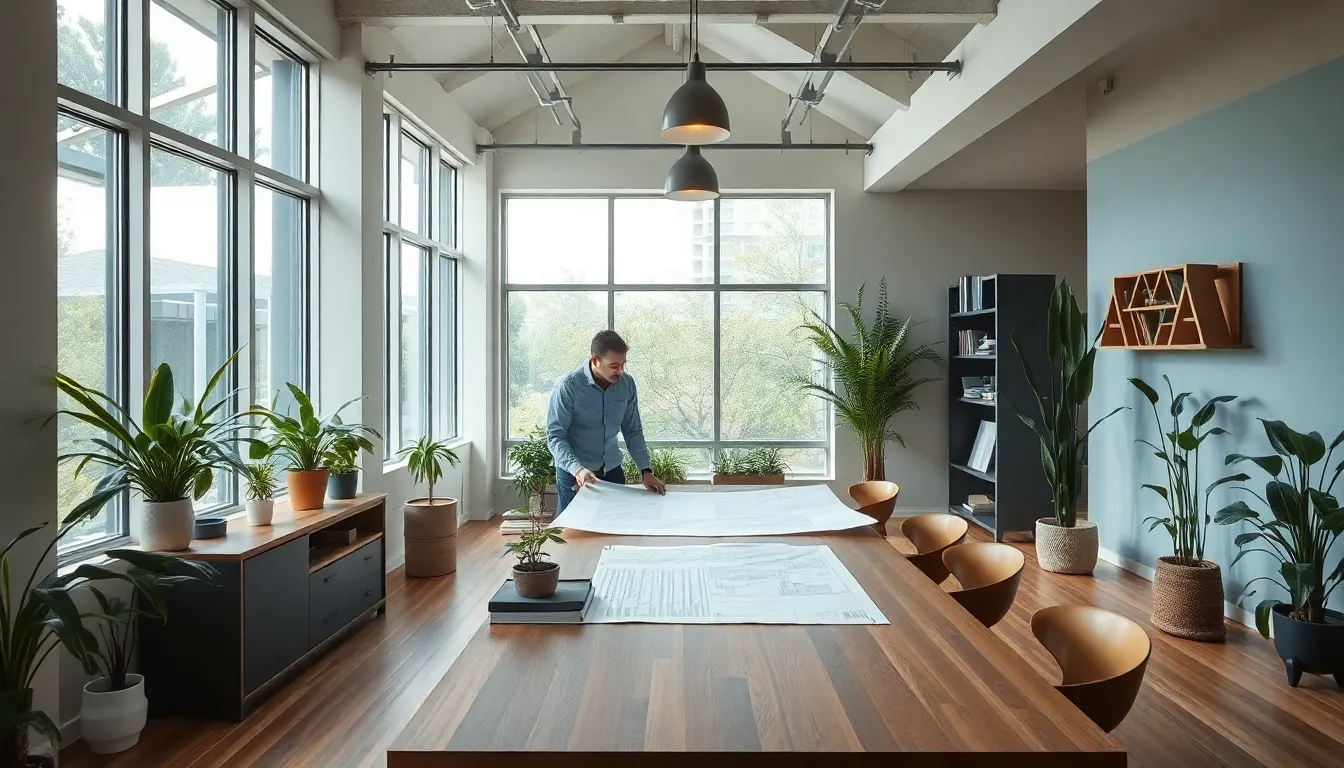Architecture isn’t just about fancy buildings and towering skyscrapers; it’s the art of crafting spaces that breathe life into our daily routines. When diving into the world of architecture and interior design, one quickly discovers it’s like assembling a complex puzzle where each piece contributes to the bigger picture. From understanding spatial dynamics to mastering color theory, there’s a treasure trove of knowledge waiting to be explored.
Imagine walking into a room that feels like a warm hug or a bustling café that sparks creativity. That’s the magic of architecture and interior design. Whether you’re a budding designer or just someone who appreciates a well-decorated space, learning about these fields can transform how you see the world around you. So, buckle up and get ready to uncover the secrets that make spaces not just livable, but downright delightful.
Understanding Architecture Kdainteriorment
Architecture Kdainteriorment merges architectural design and interior aesthetics to create integrated environments. This discipline not only considers the structural components of buildings but also emphasizes how interior spaces function and feel. Knowledge of materials plays a crucial role in this field, influencing both visual appeal and practical application.
Designers prioritize functionality alongside beauty, ensuring that each element contributes to overall harmony. Open floor plans are an example of how spatial dynamics can enhance interaction and flow within a space. Color theory significantly impacts mood and perception, guiding choices for wall treatments, furnishings, and accessories.
Sustainability increasingly becomes essential in Kdainteriorment. Eco-friendly materials and energy-efficient systems help minimize environmental impact while maintaining aesthetic integrity. Designers incorporate natural light, optimizing layouts to enhance well-being and reduce dependence on artificial lighting.
Cultural influences shape design choices, reflecting societal values and local traditions. Elements such as textures, patterns, and furniture styles connect architecture to the broader context of the community.
Additionally, the use of technology aids architects in visualizing concepts before execution. Software tools enable rapid prototyping and 3D modeling, allowing for realistic assessments of space. Collaboration with other disciplines, such as engineering and urban planning, ensures cohesive development that meets diverse needs.
Ultimately, architecture Kdainteriorment involves a deep understanding of how people interact with spaces. This comprehensive approach not only enhances aesthetics but also contributes to the functionality and livability of environments.
Key Principles of Architecture Kdainteriorment
Architecture Kdainteriorment integrates functionality, aesthetics, and sustainability, creating environments that serve the needs of their inhabitants.
Functionality
Space utilization is critical in Kdainteriorment. Architects evaluate how areas will be used, ensuring efficient layouts and seamless flow. Flexibility plays a role in design, allowing spaces to adapt for various activities. Natural light enhances functionality, improving visibility and energy efficiency. Zones can be designated for specific purposes, such as work or leisure, making everyday tasks comfortable. Accessibility principles increase usability for everyone, including individuals with different needs. Recognizing these aspects leads to designing environments that genuinely serve their intended functions.
Aesthetics
Visual appeal matters significantly in Kdainteriorment. Designers pursue harmony between interiors and structures, utilizing materials and colors that unify spaces. Proportions and balance enhance overall beauty, creating an inviting atmosphere. Personalization is encouraged, allowing individuals to express their styles through design choices. Art and decor can transform a space, adding character and vibrancy. Thoughtful design promotes emotional responses, ensuring each environment resonates with its users. Natural elements, like plants and water features, contribute to a calming aesthetic experience, fostering a connection to nature.
Sustainability
Environmental stewardship is essential in Kdainteriorment. Using eco-friendly materials minimizes waste and carbon footprints, promoting a healthier planet. Energy-efficient systems reduce consumption while maintaining comfort and functionality. Design practices encourage the utilization of local resources, supporting the community and economy. Integrating renewable energy sources helps reduce reliance on non-renewable options, enhancing sustainability. Resilient designs consider climate impacts, ensuring structures withstand challenges while remaining viable over time. Emphasizing these sustainable principles leads to responsible architecture that benefits both people and the environment.
Essential Skills to Develop
Aspiring architects and interior designers should focus on key skills that enhance the practice of Architecture Kdainteriorment. Mastering these essential abilities leads to creating integrated environments that prioritize functionality and beauty.
Design Skills
Creativity stands at the forefront of design skills. Developing a strong eye for aesthetics enables an understanding of spatial dynamics and color theory. They should explore various styles to inspire innovative ideas. Experimenting with layouts and furniture arrangements improves the ability to create inviting spaces. Engaging in continuous learning keeps them abreast of design trends and emerging materials.
Technical Knowledge
Technical knowledge forms the backbone of effective architectural practice. Proficiency in software tools, such as AutoCAD and SketchUp, allows for precise digital modeling. Understanding building codes and regulations ensures designs meet safety and accessibility standards. An awareness of sustainable materials and energy-efficient systems supports environmentally responsible choices. These elements combine to enhance both functionality and aesthetics in projects.
Communication
Strong communication skills foster collaboration among multidisciplinary teams. Articulating design concepts effectively encourages constructive feedback during the design process. Architects and interior designers benefit from presenting ideas clearly to clients, ensuring alignment with their vision. Active listening skills enhance the understanding of client needs and preferences. Establishing clear channels for communication promotes cohesive development throughout a project.
Resources for Learning
Finding the right resources enhances the understanding of Architecture Kdainteriorment. Numerous avenues exist for aspiring architects and interior designers to expand their knowledge.
Online Courses
Countless online courses offer structured learning in architecture and interior design. Platforms like Coursera and Udemy provide courses focused on key aspects such as spatial dynamics, color theory, and sustainable practices. Individuals can engage with interactive content and real-world projects, reinforcing practical skills. Institutions, such as the Massachusetts Institute of Technology, also provide specialized courses that delve into the integration of architectural design and aesthetics. Engaging in these courses cultivates a comprehensive foundation, preparing students for real-world challenges.
Books and Publications
Books and publications serve as invaluable resources for deepening knowledge about Architecture Kdainteriorment. Titles such as “A Pattern Language” by Christopher Alexander emphasize the relationship between space and human experience. Journals like the Journal of Interior Design feature the latest research and practical insights. These publications discuss contemporary trends, innovative materials, and case studies showcasing successful integration of architecture and interior design. Regularly reading this material keeps designers informed about industry advancements and evolving methodologies.
Industry Forums
Industry forums create opportunities for professionals and enthusiasts to connect and share knowledge about architecture and interior design. Websites like Archinect and Houzz foster discussions on best practices, emerging trends, and project challenges. Participating in forums allows individuals to seek advice from experienced professionals while gaining insights into real-world scenarios. Networking through these platforms enhances collaborative opportunities and fosters relationships, which are key in multidisciplinary projects. Engaging in dialogue with peers helps refine perspectives and encourages continued learning.
Conclusion
Architecture Kdainteriorment represents a dynamic fusion of design principles that elevate both functionality and aesthetics. By understanding the interplay between architectural structures and interior spaces, designers can create environments that resonate with users on multiple levels.
Emphasizing sustainability and cultural context, this approach not only meets modern demands but also honors tradition. As aspiring architects and interior designers hone their skills, they should embrace creativity and technical proficiency while fostering collaboration within multidisciplinary teams.
With the right knowledge and resources, they can transform spaces into harmonious sanctuaries that enhance daily experiences and reflect individual identities. The journey into Architecture Kdainteriorment promises to be both rewarding and impactful in shaping the future of design.





